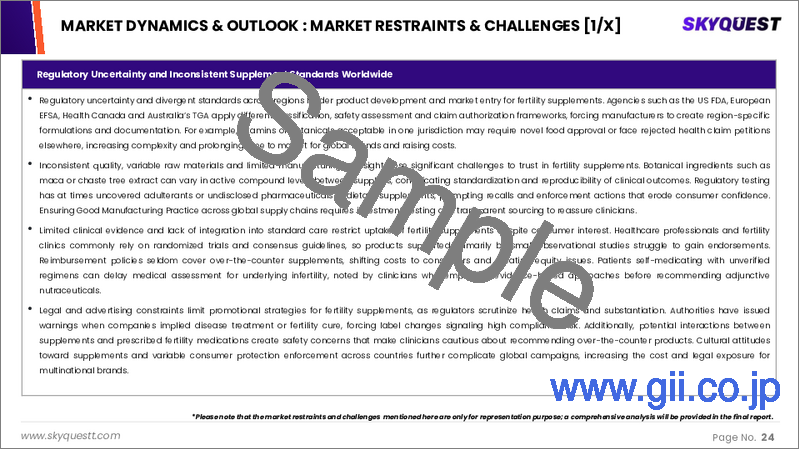|
|
市場調査レポート
商品コード
1677994
妊活サプリ市場規模、シェア、成長分析:成分タイプ別、製品別、流通チャネル別、エンドユーザー別、地域別 - 産業予測 2025~2032年Fertility Supplements Market Size, Share, and Growth Analysis, By Ingredient Type (Natural, Synthetic), By Product (Capsules, Tablets), By Distribution Channel, By End User, By Region - Industry Forecast 2025-2032 |
||||||
|
|||||||
| 妊活サプリ市場規模、シェア、成長分析:成分タイプ別、製品別、流通チャネル別、エンドユーザー別、地域別 - 産業予測 2025~2032年 |
|
出版日: 2025年03月07日
発行: SkyQuest
ページ情報: 英文 198 Pages
納期: 3~5営業日
|
全表示
- 概要
- 目次
妊活サプリ市場規模は2023年に21億米ドルと評価され、2024年の22億6,000万米ドルから2032年には40億9,000万米ドルに成長し、予測期間(2025-2032年)のCAGRは7.7%で成長する見通しです。
妊活サプリ市場は、不妊率の上昇と生殖機能強化のための栄養補助食品に対する意識の高まりによって成長する見込みです。店頭での入手が可能なことも、この需要をさらに後押ししています。しかし、規制監督の欠如、一貫性のない製品品質、高コストといった課題が、入手の妨げになる可能性があります。さらに、こうしたサプリメントの有効性を裏付ける科学的根拠をめぐる懐疑的な見方や、不妊症にまつわる汚名が市場の拡大を抑制する可能性もあります。逆に、eコマースの利用拡大や個別化された栄養摂取の動向は、技術革新と製品の多様化という新たな機会をもたらします。生殖機能を改善するための代替アプローチを求める個人が増えるにつれて、世界の妊活サプリ市場は、安全性と有効性を確保するための規制や品質上の懸念への対処を条件として、成長すると予想されます。
目次
イントロダクション
- 調査の目的
- 調査範囲
- 定義
調査手法
- 情報調達
- 二次と一次データの方法
- 市場規模予測
- 市場の前提条件と制限
エグゼクティブサマリー
- 世界市場の見通し
- 供給と需要の動向分析
- セグメント別機会分析
市場力学と見通し
- 市場概要
- 市場規模
- 市場力学
- 促進要因と機会
- 抑制要因と課題
- ポーターの分析
主な市場の考察
- 重要成功要因
- 競合の程度
- 主な投資機会
- 市場エコシステム
- 市場の魅力指数(2024年)
- PESTEL分析
- マクロ経済指標
- バリューチェーン分析
- 価格分析
- 規制情勢
- ケーススタディ
- 技術の進歩
妊活サプリ市場規模:成分タイプ別& CAGR(2025-2032)
- 市場概要
- 天然
- 合成
妊活サプリ市場規模:製品別& CAGR(2025-2032)
- 市場概要
- カプセル
- タブレット
- ソフトジェル
- 粉末
- 液体
妊活サプリ市場規模:流通チャネル別& CAGR(2025-2032)
- 市場概要
- 店頭
- 処方
妊活サプリ市場規模:エンドユーザー別& CAGR(2025-2032)
- 市場概要
- 男性
- 女性
妊活サプリ市場規模:地域別& CAGR(2025-2032)
- 北米
- 米国
- カナダ
- 欧州
- ドイツ
- スペイン
- フランス
- 英国
- イタリア
- その他欧州地域
- アジア太平洋地域
- 中国
- インド
- 日本
- 韓国
- その他アジア太平洋地域
- ラテンアメリカ
- ブラジル
- その他ラテンアメリカ地域
- 中東・アフリカ
- GCC諸国
- 南アフリカ
- その他中東・アフリカ
競合情報
- 上位5社の比較
- 主要企業の市場ポジショニング(2024年)
- 主な市場企業が採用した戦略
- 最近の市場動向
- 企業の市場シェア分析(2024年)
- 主要企業の企業プロファイル
- 企業の詳細
- 製品ポートフォリオ分析
- 企業のセグメント別シェア分析
- 収益の前年比比較(2022-2024)
主要企業プロファイル
- Fairhaven Health(USA)
- Coast Science(USA)
- Lenus Pharma GesmbH(Austria)
- Active Bio Life Science GmbH(Germany)
- Orthomol(Germany)
- Exeltis USA, Inc.(USA)
- Bionova(India)
- Fertility Nutraceuticals LLC(USA)
- Vitabiotics Ltd.(UK)
- Extreme V, Inc.(USA)
- Xena Bio Herbals Pvt. Ltd.(India)
- Gonadosan Distribution GmbH(Fertilovit)(Austria)
- InnovaMed Ltd.(Amino Expert)(UK)
- Babystart Ltd.(UK)
- Crown Nutraceuticals(USA)
- Sal Nature LLC(USA)
- Yadtech(Israel)
- Prega News(India)
- PlusPlus Lifesciences LLP(India)
結論と提言
Fertility Supplements Market size was valued at USD 2.1 billion in 2023 and is poised to grow from USD 2.26 billion in 2024 to USD 4.09 billion by 2032, growing at a CAGR of 7.7% during the forecast period (2025-2032).
The fertility supplements market is poised for growth, driven by rising infertility rates and increased awareness of dietary supplements for reproductive health enhancement. Over-the-counter availability further fuels this demand. However, challenges such as a lack of regulatory oversight, inconsistent product quality, and high costs may hinder accessibility. Additionally, skepticism surrounding the scientific evidence supporting the efficacy of these supplements and the stigma associated with infertility can restrain market expansion. Conversely, the growing use of e-commerce and the trend toward personalized nutrition present new opportunities for innovation and product variety. As more individuals seek alternative approaches to improve reproductive health, the global fertility supplements market is expected to grow, contingent on addressing regulatory and quality concerns to ensure safety and effectiveness.
Top-down and bottom-up approaches were used to estimate and validate the size of the Fertility Supplements market and to estimate the size of various other dependent submarkets. The research methodology used to estimate the market size includes the following details: The key players in the market were identified through secondary research, and their market shares in the respective regions were determined through primary and secondary research. This entire procedure includes the study of the annual and financial reports of the top market players and extensive interviews for key insights from industry leaders such as CEOs, VPs, directors, and marketing executives. All percentage shares split, and breakdowns were determined using secondary sources and verified through Primary sources. All possible parameters that affect the markets covered in this research study have been accounted for, viewed in extensive detail, verified through primary research, and analyzed to get the final quantitative and qualitative data.
Fertility Supplements Market Segments Analysis
Global Fertility Supplements Market is segmented by Ingredient Type, Product, Distribution Channel, End User and region. Based on Ingredient Type, the market is segmented into Natural and Synthetic. Based on Product, the market is segmented into Capsules, Tablets, Soft gels, Powders and Liquids. Based on Distribution Channel, the market is segmented into OTC and Prescribed. Based on End User, the market is segmented into Men and Women. Based on region, the market is segmented into North America, Europe, Asia Pacific, Latin America and Middle East & Africa.
Driver of the Fertility Supplements Market
The fertility supplements market is driven by the increasing recognition of their role in enhancing hormonal balance, stimulating ovulation, and boosting the chances of conception and childbirth for both men and women. Infertility can arise from various factors, including hormonal imbalances that lead to low sperm count or poor sperm motility in men. Various lifestyle factors, such as tobacco use, which impacted 22.3% of the global population in 2020, significantly contribute to fertility issues. With tobacco use causing around 8 million deaths annually, its adverse effects further amplify the demand for effective fertility supplements, highlighting their importance in addressing reproductive health challenges.
Restraints in the Fertility Supplements Market
Despite the growing popularity of fertility supplements, one significant restraint in the market is the insufficient scientific evidence substantiating their effectiveness. Numerous claims made by manufacturers often lack the backing of rigorous clinical trials or comprehensive studies, resulting in skepticism from both healthcare professionals and consumers. This absence of validated research raises concerns about the reliability and efficacy of these products, potentially hindering their acceptance in the healthcare community and limiting consumer trust. As a result, the lack of substantiated evidence may impede the growth and expansion of the fertility supplements market.
Market Trends of the Fertility Supplements Market
The fertility supplements market is witnessing a notable trend toward the increasing demand for natural and organic products. As consumers become more health-conscious, there is a significant shift away from synthetic alternatives in favor of supplements derived from natural ingredients like herbs, vitamins, and minerals. This preference is driven by perceptions of safety, fewer side effects, and a desire for holistic wellness solutions. Products like In Folic, which combines myo-inositol and folic acid, exemplify this trend, gaining popularity for their effective and naturally sourced compositions. This shift is likely to shape the future landscape of the fertility supplements market as awareness of organic options continues to rise.
Table of Contents
Introduction
- Objectives of the Study
- Scope of the Report
- Definitions
Research Methodology
- Information Procurement
- Secondary & Primary Data Methods
- Market Size Estimation
- Market Assumptions & Limitations
Executive Summary
- Global Market Outlook
- Supply & Demand Trend Analysis
- Segmental Opportunity Analysis
Market Dynamics & Outlook
- Market Overview
- Market Size
- Market Dynamics
- Drivers & Opportunities
- Restraints & Challenges
- Porters Analysis
- Competitive rivalry
- Threat of substitute
- Bargaining power of buyers
- Threat of new entrants
- Bargaining power of suppliers
Key Market Insights
- Key Success Factors
- Degree of Competition
- Top Investment Pockets
- Market Ecosystem
- Market Attractiveness Index, 2024
- PESTEL Analysis
- Macro-Economic Indicators
- Value Chain Analysis
- Pricing Analysis
- Regulatory Landscape
- Case Studies
- Technological Advancement
Global Fertility Supplements Market Size by Ingredient Type & CAGR (2025-2032)
- Market Overview
- Natural
- Synthetic
Global Fertility Supplements Market Size by Product & CAGR (2025-2032)
- Market Overview
- Capsules
- Tablets
- Soft gels
- Powders
- Liquids
Global Fertility Supplements Market Size by Distribution Channel & CAGR (2025-2032)
- Market Overview
- OTC
- Prescribed
Global Fertility Supplements Market Size by End User & CAGR (2025-2032)
- Market Overview
- Men
- Women
Global Fertility Supplements Market Size & CAGR (2025-2032)
- North America (Ingredient Type, Product, Distribution Channel, End User)
- US
- Canada
- Europe (Ingredient Type, Product, Distribution Channel, End User)
- Germany
- Spain
- France
- UK
- Italy
- Rest of Europe
- Asia Pacific (Ingredient Type, Product, Distribution Channel, End User)
- China
- India
- Japan
- South Korea
- Rest of Asia-Pacific
- Latin America (Ingredient Type, Product, Distribution Channel, End User)
- Brazil
- Rest of Latin America
- Middle East & Africa (Ingredient Type, Product, Distribution Channel, End User)
- GCC Countries
- South Africa
- Rest of Middle East & Africa
Competitive Intelligence
- Top 5 Player Comparison
- Market Positioning of Key Players, 2024
- Strategies Adopted by Key Market Players
- Recent Developments in the Market
- Company Market Share Analysis, 2024
- Company Profiles of All Key Players
- Company Details
- Product Portfolio Analysis
- Company's Segmental Share Analysis
- Revenue Y-O-Y Comparison (2022-2024)
Key Company Profiles
- Fairhaven Health (USA)
- Company Overview
- Business Segment Overview
- Financial Updates
- Key Developments
- Coast Science (USA)
- Company Overview
- Business Segment Overview
- Financial Updates
- Key Developments
- Lenus Pharma GesmbH (Austria)
- Company Overview
- Business Segment Overview
- Financial Updates
- Key Developments
- Active Bio Life Science GmbH (Germany)
- Company Overview
- Business Segment Overview
- Financial Updates
- Key Developments
- Orthomol (Germany)
- Company Overview
- Business Segment Overview
- Financial Updates
- Key Developments
- Exeltis USA, Inc. (USA)
- Company Overview
- Business Segment Overview
- Financial Updates
- Key Developments
- Bionova (India)
- Company Overview
- Business Segment Overview
- Financial Updates
- Key Developments
- Fertility Nutraceuticals LLC (USA)
- Company Overview
- Business Segment Overview
- Financial Updates
- Key Developments
- Vitabiotics Ltd. (UK)
- Company Overview
- Business Segment Overview
- Financial Updates
- Key Developments
- Extreme V, Inc. (USA)
- Company Overview
- Business Segment Overview
- Financial Updates
- Key Developments
- Xena Bio Herbals Pvt. Ltd. (India)
- Company Overview
- Business Segment Overview
- Financial Updates
- Key Developments
- Gonadosan Distribution GmbH (Fertilovit) (Austria)
- Company Overview
- Business Segment Overview
- Financial Updates
- Key Developments
- InnovaMed Ltd. (Amino Expert) (UK)
- Company Overview
- Business Segment Overview
- Financial Updates
- Key Developments
- Babystart Ltd. (UK)
- Company Overview
- Business Segment Overview
- Financial Updates
- Key Developments
- Crown Nutraceuticals (USA)
- Company Overview
- Business Segment Overview
- Financial Updates
- Key Developments
- Sal Nature LLC (USA)
- Company Overview
- Business Segment Overview
- Financial Updates
- Key Developments
- Yadtech (Israel)
- Company Overview
- Business Segment Overview
- Financial Updates
- Key Developments
- Prega News (India)
- Company Overview
- Business Segment Overview
- Financial Updates
- Key Developments
- PlusPlus Lifesciences LLP (India)
- Company Overview
- Business Segment Overview
- Financial Updates
- Key Developments





